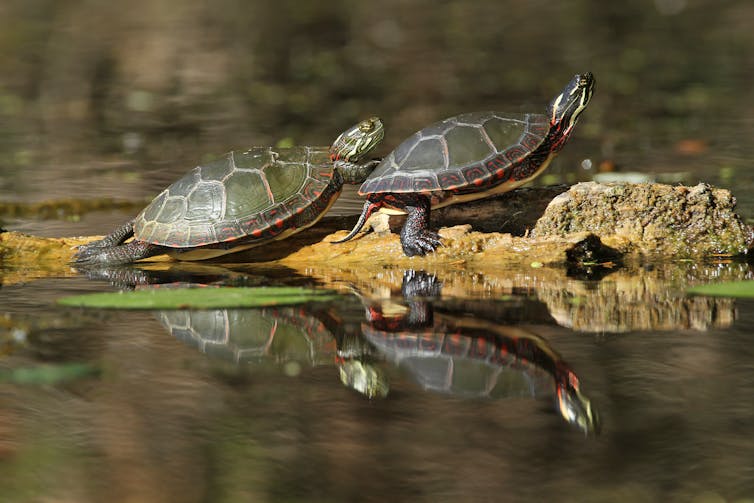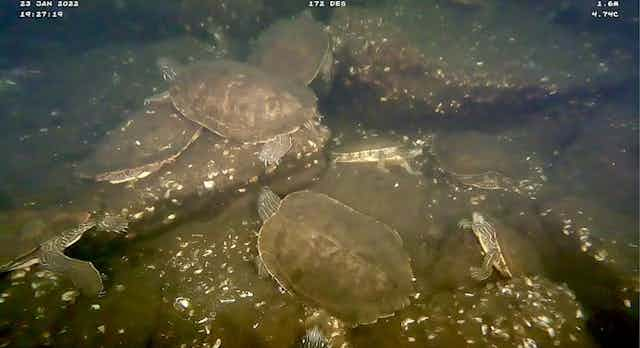On a crisp February day, a filmmaker and I were walking across the 45-centimetre-thick ice covering Opinicon Lake, a small lake in eastern Ontario. We were heading for a very special spot where hundreds of northern map turtles coalesce every year to spend the winter months. The filmmaker stuck a camera attached to a long pole in holes drilled through the ice to capture turtles for a nature documentary.
Read more: Northern map turtles survive cold winter conditions by staying active under ice
As we spotted our first turtles on the monitor, the filmmaker confided that he would like to get a shot of a turtle’s rear end. Strange as it sounds, this request didn’t surprise me. The filmmaker wanted to show overwintering turtles breathing with their butts. I had disappointing news for him.
I can’t blame the filmmaker for expecting to observe this bizarre form of respiration in our overwintering turtles. A quick Google search turns up several stories about butt-breathing turtles, many from credible sources.
A handful of turtles can breathe through their butts — it’s called cloacal gas exchange — but they are distant relatives of the North American species often claimed to do so in winter. But as far as scientific evidence goes, North American turtles overwintering in ice-covered water bodies don’t survive by breathing through their butts.
Mysterious cloacal sacs
In turtles, as in other reptiles (including birds), the reproductive and digestive tracts merge into a single pipe called the cloaca. Some species of turtles have a pair of sacs sprouting from their cloacal passage. These sacs, called cloacal bursae, are different from the single urinary bladder.
The function of cloacal bursae has baffled anatomists and physiologists for more than two centuries. In 1998, C. Barker Jørgenson published a historical overview of the research on these structures since their discovery.
According to Jørgensen, the anatomist Hans Gadow was the first to invoke a respiratory function for the sacs in a 1901 book called Amphibia and Reptiles. Gadow wrote that “these sacs, which have highly vascularised walls, are incessantly filled and emptied with water through the vent, and act as important respiratory organs.”
This suggestion of a respiratory function, Jørgenson pointed out, became widely accepted without any supporting evidence.

Butt-breathing turtles
Evidence of cloacal respiration did eventually come from research on Australian freshwater turtles, such as the saw-shelled turtle and the white-throated snapping turtle. The inner surface of the bursae in these species is densely lined with tiny finger-like projections called papillae which are themselves packed with tiny blood vessels. The papillae appear to function like gills.
A turtle pumps water into its cloaca and the oxygen dissolved in the water is absorbed by the blood vessels in the papillae while carbon dioxide diffuses from the blood to the water. The turtle then expels the stale water out of its cloaca and pumps fresh water back in. Even when the water is warm and the demand for oxygen high, some of these Australian turtles remain submerged for hours, relying on their cloacal bursae to get the oxygen they need.
These findings are remarkable, but North American turtles do not have the same cloacal superpowers.
Distant cousins
All living turtles fall in one of two groups: the hidden-necked and the side-necked. The groups are named after the way the necks of their members bends.
More importantly, these two groups represent two branches in the turtle family tree. The Australian cloacal breathers are on the side-necked branch. These turtles are only found in the southern hemisphere.
All turtles living in the cold northern hemisphere are on the hidden-necked branch. The hidden-necked and side-necked branches split around 200 million years ago.

Lots of evolution can happen in 200 million years. For context, placental mammals like us parted ways from our egg-laying cousins like the duck-billed platypus about 166 million years ago.
Side-necked and hidden-necked turtles have amassed many differences during their 200-million-years-long journey apart, despite their physical similarities. Some of these differences appear to be in their cloaca.
To date, there is no evidence that hidden-necked turtles — like painted turtles, sliders, map turtles and snapping turtles — sport the gas exchange hardware of their distant side-necked cousins.
It is worth noting that not all turtles have cloacal bursae. For instance, the spiny softshell and the common musk turtle lack them.
Both species range as far north as southern Canada where they spend several months under the ice every year.
Breathing through the winter
The first published suggestion that overwintering turtles employ cloacal gas exchange appeared in 1958. Herpetologists Hobart Smith and Louis James published a review on cloacal bursae, where they wrote: “It is our opinion that the presence of bursae indicates a capacity to survive under water at low temperatures for long periods.”
In a followup study, published in 1961, Smith experimentally tested the gas exchange hypothesis and failed to convincingly demonstrate a respiratory function for the bursae in several North American species known to overwinter in water. Successive attempts have showed no, or a minute amount of, gas exchange within the cloaca.
The most recent test of cloacal gas exchange in a hidden-necked turtle was led by the late physiologist Donald C. Jackson, author of Life in a Shell: A Physiologist’s View of a Turtle. In this 2004 study, Jackson and his collaborators examined gas exchange in painted turtles submerged in cold water.

Painted turtles, found throughout North America, have one of the longest overwintering periods of any aquatic turtles. Although they can survive for months without oxygen, they can breathe underwater when oxygen is present. The physiologists experimentally manipulated the ability of painted turtles to breathe through their skin, mouth and cloaca to figure out which of these body parts are involved in gas exchange.
The researchers found no evidence that aquatic gas exchange took place in the cloaca, but showed that it was the turtles’ skin that performed this function.
Hot air
It is ironic that the one species in which cloacal gas exchange has been thoroughly rejected on morphological and physiological grounds is often used as the poster child for winter butt-breathing. The image of a turtle using its butt to breathe while locked under the ice for months is appealing, but as far as scientific evidence goes, it is nothing but hot air.
The notion that cloacal gas exchange helps North American turtles survive long winters trapped under the ice is pervasive in pop science, but to date, there is no solid evidence that hidden-necked turtles use cloacal gas exchange. The skin and mouth lining are where gas exchange happens during winter hibernation.
As for the cloacal bursae, their function in hidden-necked turtles remains unclear, but they may help control buoyancy in some species.

